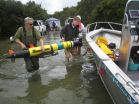(Press-News.org) WASHINGTON — A new, detailed record of rainfall fluctuations in ancient Mexico that spans more than twelve centuries promises to improve our understanding of the role drought played in the rise and fall of pre-Hispanic civilizations.
Prior evidence has indicated that droughts could have been key factors in the fates of major cultures in ancient Mexico and Central America (Mesoamerica). But there have been many gaps in the paleoclimate record, such as the exact timing and geographic extension of some seemingly influential dry spells.
The new, 1,238-year-long tree-ring chronology, the longest and most accurate of its kind for Mesoamerica, is the first to reconstruct the climate of pre-colonial Mexico on an annual basis for more than a millennium, pinning down four ancient megadroughts to their exact years.
One large ancient drought previously confirmed for the Southwest of the United States is shown to have extended into central Mexico (1149-1167 AD) by the new dendrochronology, or tree-ring reconstruction. There it may have devastated the local maize crops, potentially giving a fatal blow to the declining Toltec culture, says David Stahle, a paleoclimatologist at the University of Arkansas at Fayetteville and lead author of the new study. Stahle and his colleagues present their new findings in a paper that has been accepted for publication in Geophysical Research Letters, a journal of the American Geophysical Union.
The new record also pins down more precisely than ever before the time periods of two other extended and severe dry periods, possibly leading to new insights into the Aztecs's rise to power, and into the spread of exotic diseases that Spanish Conquistadores brought to America.
This far-reaching rainfall chronology also provides the first independent confirmation of the so-called Terminal Classic drought, a megadrought some anthropologists relate to the collapse of the Mayan civilization. This decades-long dry period had been previously determined by analysis of lake and basin sediments in other areas of Mexico and the Caribbean. But Stahle's team has narrowed the event's timing to 897-922 AD and confirmed that it had a wider geographical impact than previously thought, extending into the highlands of Central Mexico, where other classic period cultures were located.
"Certainly these cultural changes were very complicated — probably not one single explanation can account for the collapse of the Mayan civilization," Stahle says. "[But] our study will allow other scientists to more thoroughly investigate and understand the impact of these droughts."
Stahle and his team used data from 74 core samples extracted from 30 specimens of millennium-old Montezuma baldcypress trees (Taxodium mucronatum) growing in the canyon of Amealco, Queretaro – only 90 kilometers (56 miles) away from Tenochtitlan, capital of the Aztec empire, and 60 km (37 miles) northeast from Tula, the Toltec state's main city. Stahle says this tree species, related to North American sequoias, is the only plant in Central America that frequently lives up to one thousand years or more.
"This is the national tree of Mexico, and it tells such an interesting story of the decline of the Mexican empires", says Stahle, adding that previous tree chronologies for Mexico were only three to four centuries long. "This is the first one that goes back into pre-Hispanic times,"
The researchers determined the year of formation for each tree ring and analyzed what the rings' growth patterns had to say about how soil moisture varied from growth season to growth season over the years, a parameter directly associated with rainfall. "The beauty of tree rings is that they're annual: you get an estimate for wetness for every single year – you don't get it from other archives, not as precisely," Stahle says.
"This research … highlights the role fine-grained climate data can play in helping us understand the trajectories of past human societies," says David Anderson, an archaeologist at the University of Tennessee, Knoxville who was not involved in the new study. "This study will prompt a great deal of follow-up research by archaeologists and paleoclimatologists alike, and offers lessons for our own civilization — specifically how vulnerable complex societies may be to drought-induced crop failures."
###
This research received funding from the National Science Foundation's Paleoclimatology Program and the Inter-American Institute for Global Change Research.
Notes for Journalists
As of the date of this press release, the paper by Stahle et al. is still "in press" (i.e., not yet published). Journalists and public information officers (PIOs) of educational and scientific institutions who have registered with AGU can download a PDF copy of this paper by clicking on this link:
http://www.agu.org/journals/pip/gl/2010GL046472-pip.pdf
Or, you may order a copy of the paper by emailing your request to Maria-José Viñas (mjvinas@agu.org) or Melissa Lutz Blouin (blouin@uark.edu). Please provide your name, the name of your publication, and your phone number.
Neither the paper nor this press release are under embargo.
Title:
"Major Mesoamerican Droughts of the Past Millennium"
Authors:
D.W. Stahle, D.K. Stahle, D.J. Burnette, F.K. Fye, M.K. Cleaveland: Department of Geosciences, University of Arkansas, Fayetteville, Arkansas, USA;
J. Villanueva Diaz, J. Cerano Paredes: Laboratorio de Dendrocronologia, Instituto Nacional de Investigaciones Forestales, Agricolas, y Pecuarias, Durango, Mexico;
R.R. Heim, Jr.: Climate Services and Monitoring Division, NOAA's National Climatic Data Center, Asheville, North Carolina, USA;
R. Acuna Soto: Departamento Microbiologia y Parasitologia, UNAM, Mexico, D.F., Mexico;
M.D. Therrell: Department of Geography, Southern Illinois University, Carbondale, Illinois, USA.
Contact information for the author:
David Stahle, Telephone: +1 (479) 575-3703 or +1 (479) 443-0346 , Email: dstahle@uark.edu
University of Arkansas Contact:
Melissa Lutz Blouin
+1 (479) 575-5555
blouin@uark.edu
END
A growing global population has lead to increasing demands for food. Farmers around the world rely, at least in part on phosphorus-based fertilizers in order to sustain and improve crop yields. But the overuse of phosphorus can lead to freshwater pollution and the development of a host of problems, such as the spread of blue-green algae in lakes and the growth of coastal 'dead zones'.
A further issue is that phosphorus comes from phosphate rock, a non-renewable resource of which there are limited supplies in such geopolitically charged areas as Western Sahara and China.
Now, ...
New discoveries on how underwater ridges impact the ocean's circulation system will help improve climate projections.
An underwater ridge can trap the flow of cold, dense water at the bottom of the ocean. Without the ridge, deepwater can flow freely and speed up the ocean circulation pattern, which generally increases the flow of warm surface water.
Warm water on the ocean's surface makes the formation of sea ice difficult. With less ice present to reflect the sun, surface water will absorb more sunlight and continue to warm.
U.S. Geological Survey scientists looked ...
COLUMBIA, Mo. – Starbucks recently announced a new-sized 31-ounce drink, the "Trenta," which will be in stores this spring. The mega-sized coffee joins the ranks of other energy drinks that can pack plenty of caffeine and calories. Ellen Schuster, a University of Missouri nutrition expert, says that Americans should be wary of extra calories and sugar in the quest for bigger, bolder drinks.
"The sheer size of new coffee and energy drinks increases consumers' potential for unhealthy calorie and sugar consumption," said Schuster, state specialist for MU Extension and the ...
RENO, Nev. – A team of University of Nevada, Reno and University of Nevada, Las Vegas researchers have devised a new model for how Nevada's gold deposits formed, which may help in exploration efforts for new gold deposits.
The deposits, known as Carlin-type gold deposits, are characterized by extremely fine-grained nanometer-sized particles of gold adhered to pyrite over large areas that can extend to great depths. More gold has been mined from Carlin-type deposits in Nevada in the last 50 years – more than $200 billion worth at today's gold prices – than was ever mined ...
They were called the Eighth Wonder of the World. Until the late 19th century, New Zealand's Pink and White Terraces along Lake Rotomahana on the North Island, attracted tourists from around the world, interested in seeing the beautiful natural formations created by a large geothermal system. But the eruption of Mt. Tarawera on June 10, 1886, buried the terraces in sediment and caused the lake basin to enlarge, engulfing the land where the terraces stood. For more than a century, people have speculated whether any part of the Pink and White Terraces survived the eruption.
This ...
Mom's touch and diet – Claire-Dominique Walker, PhD, director, Neuroscience Research Division, Douglas Institute.
The quality and quantity of maternal milk and maternal-infant contact impact the stress response of the adult offspring, according to recent research published in Developmental Psychobiology. "This manuscript reviews and highlights how critical factors early in life can shape the physiology and behaviour of adult offspring," says Claire-Dominique Walker, Douglas research scientist and study senior author. "For example, we have shown that, in rodent models, ...
Homeless people who do not get enough to eat use hospitals and emergency rooms at very high rates, according to a new study. One in four respondents to a nationwide survey reported not getting enough to eat, a proportion six times higher than in the general population, and more than two thirds of those had recently gone without eating for a whole day. The report will appear in the Journal of General Internal Medicine and has been released online.
"The study is the first to highlight the association between food insufficiency and health care use in a national sample ...
(WASHINGTON, February 3, 2011) – For blood cancer patients at high risk of relapse, hematopoietic stem cell transplantation (HSCT), the transplantation of blood-forming stem cells, is one of best options for treatment and a potential cure. Unfortunately, the most common complication of HSCT is graft-versus-host disease (GVHD), a serious and often deadly post-transplant complication that occurs when the newly transplanted donor cells recognize the recipient's own cells as foreign and react by attacking the cells in the patient's body. A study published today in Blood, the ...
The Gerontological Society of America (GSA) — the nation's largest interdisciplinary organization devoted to the field of aging — commends the federal government's recent release of the "2010 Dietary Guidelines for Americans" and particularly applauds its inclusion of specific advice for older adults.
Because more than one-third of children and more than two-thirds of adults in the U.S. are overweight or obese, the 7th edition of "Dietary Guidelines for Americans," issued by the Department of Agriculture and the Department of Health and Human Services, places stronger ...
BOULDER--The aggressive wolverine may not be powerful enough to survive climate change in the contiguous United States, new research concludes.
Wolverine habitat in the northwestern United States is likely to warm dramatically if society continues to emit large amounts of greenhouse gases, according to new computer model simulations carried out at the National Center for Atmospheric Research (NCAR). The study found that climate change is likely to imperil the wolverine in two ways: reducing or eliminating the springtime snow cover that wolverines rely on to protect and ...


